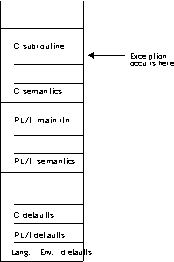Exception occurs in C
This scenario describes the behavior of an application that contains a C and a PL/I routine. Refer to Figure 1 throughout the following discussion. In this scenario, a PL/I main routine invokes a C subroutine. An exception occurs in the C subroutine.
Figure 1. Stack contents when the exception
occurs in C

The actions taken are the following:
- In the enablement step, it is determined whether the exception
in the C routine should be enabled and treated as a condition. If
any of the following are true, the exception is ignored, and processing
continues at the next sequential instruction after where the exception
occurred:
- You specified SIG_IGN for the exception in a
call to signal(). Note: The system or user abend corresponding to the signal(SIGABND) or the Language Environment message 3250 is not ignored. The enclave is terminated.
- The exception is one of those listed as masked in Table 2, and you have not enabled it using the CEE3SPM callable service.
- You did not specify any action, but the default action for the condition is SIG_IGN (see Table 2).
- You are running under CICS® and a CICS handler is pending.
- You specified SIG_IGN for the exception in a
call to signal().
- If a user-written condition handler has been registered on the
stack frame using CEEHDLR, it is given control.
If it issues a resume, the condition handling step ends. Processing continues in the routine to which the resume cursor points.
In this example, no user-written condition handler is registered for the condition, so the condition is percolated.
- If a C signal handler has been registered for the condition on
the C stack frame, it is given control. If it successfully issues
a resume or a call to longjmp(), the condition handling
step ends. Processing resumes in the routine to which the resume cursor
points.
In this case, there is not a C signal handler registered for the condition.
- The condition is still unhandled. If C does not recognize the condition, or if the C default action (listed in Table 2) is to terminate, the condition is percolated.
- If a user-written condition handler has been registered on the PL/I stack frame using CEEHDLR, it is given control. If it issues a resume, the condition handling step ends. Processing continues in the routine at the point where the resume cursor points. In this example, no user-written condition handler is registered for the condition, so the condition is percolated.
- If an ON-unit has been established for the condition being processed on the PL/I stack frame, it is given control. If it issues a GOTO out-of-block, the condition handling step ends. Execution resumes at the label of the GOTO. In this example, no ON-unit is established for the condition, so the condition is percolated.
- What happens next depends on whether the condition is promotable
to the PL/I ERROR
condition. The following can happen:
- If the condition is not promotable to the PL/I ERROR condition, then the Language Environment default actions take place, as described in Table 1. Condition handling ends.
- If the PL/I default action for the condition is to promote it to the PL/I ERROR condition, the condition is promoted, and another pass is made of the stack to look for ERROR ON-units or user-written condition handlers. If an ERROR ON-unit or user-written condition handler is found, it is invoked.
- If either of the following occurs:
- An ERROR ON-unit or user-written condition handler is found, but it does not issue a GOTO out of block or similar construct
- No ERROR ON-unit or user-written condition handler is found
- If no condition handler moves the resume cursor and issued a resume, Language Environment terminates the thread.